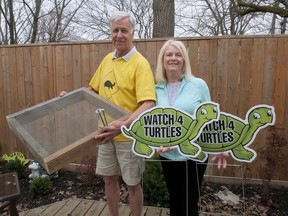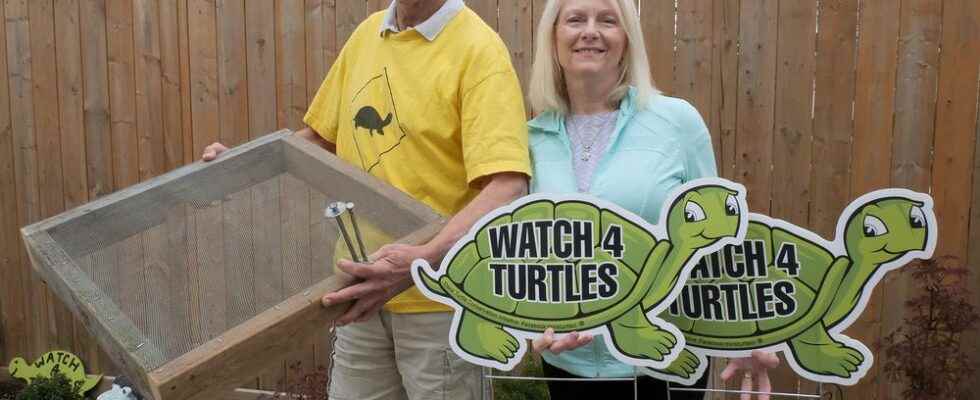
Long Point volunteer John Everett will once again distribute a limited number of Long Point Biosphere Region ‘Watch 4 Turtles’ signs and nesting boxes during the nesting season this year.
“We’re sort of an awareness campaign with the Watch 4 Turtles signs,” said Everett.
If you have a sign from past years, now would be a great time to get it out and place it on your front lawn.
Most years, turtle nesting starts in the first week of May if it is warm enough and the nesting season goes until into July. This year it has been a colder spring.
“They’re not really nesting right now,” Everett noted.
“The turtles aren’t on the move right now because of the cooler weather, but when people see turtles they will contact me and we will flood the area with ‘Watch 4 Turtles’ signs.”
The signs are free, said Jan Everett.
Contact John by text to arrange for pick up or delivery in Norfolk County at 519-777-2873.
“If we get a few people from Tillsonburg that want them, we’ll make a trip to deliver them,” he said.

NEVER GIVE UP
John and his wife Jan have been partnering with the Long Point Biosphere Region since 2013 when Jan wrote a children’s book, Never Give Up, honoring John’s life-long turtle-saving efforts. More than 4,000 books have been sold worldwide over the years.
“We go all over Southern Ontario promoting the book and saving turtles,” said John. “We had been taking books to Point Pelee National Park (near Leamington) about four years ago and we saw these ‘cage things’ on the side of the road. So we pulled over, took a picture, came back to Long Point and showed them to Rick Levick, who was in charge of the Long Point Causeway Improvement Project and former president of the biosphere. He thought this was a great idea.”
Thirty cages were built locally, and when people saw turtles laying eggs, they could ask for a cage.
“Because of the high water levels we’ve had over the last 3-4 years, turtles have gone to higher ground,” John noted. “So they are laying their eggs here on people’s cottage properties.”
The nesting boxes help protect eggs from predators, primarily raccoons and fox.
“A turtle lays the eggs, then leaves the area, and it takes about 90-120 days for eggs to hatch. So the cage protects them from predators.”
The No. 2 issue for turtle mortality is roads, and that’s why the sign and awareness campaign is important.
“It’s a perfect twofold thing – the signs and the boxes,” Jan nodded.
“Three years ago Rick Levick thought of the sign idea and we got 100 signs and we gave them out to people,” said John. “They are very, very popular.”
They distributed another 100 signs two years ago.
“The look so cute on your lawn,” Jan smiled.
Another 100 signs and 30 cages are available this year.
John remembers receiving a call in Long Point about a snapping turtle on a cottage property. He suggested ‘letting it do what it wanted to do.’
The next day, he got another call. The turtle had laid eggs, so he brought over a sign and a nesting cover cage. Ninety days later, the eggs hatched and the family watched 19 baby turtles emerge from the nest. The baby turtles were taken in a bucket to the marsh to protect them.
“Their grandchildren named the babies as they came out,” John said. “And they ran out of names!”
“It was an event,” Jan laughed. “So cute.”
It is beneficial to have turtles in the ecosystem – even snapping turtles.
“They are nature’s vacuum cleaners,” said John. “They are the janitors. They clean up all the flotsam and jetsam in the marsh. They eat the dead vegetation and the dead animals, and that takes the harmful bacteria out of the water. Snapping turtles moreso than any because they can last 60-70 years and they are big.”
“And they eat a lot,” Jan added.
“If you have a healthy turtle population, you have a healthy ecosystem,” said John.
“Turtles cross the road three times a year. Once to lay their eggs. Once in the middle of June to find their summer habitat, and then in the fall to hibernate.”
To help promote turtle morality prevention, Environment Canada is posting new metal wildlife awareness signs for turtles and snakes near ‘hot spots’ and much larger ‘Drive Cautiously’ (6′ x 8′) road signs.
“They have the data, they know where the hot spots are, where turtles are crossing the road,” said John. “They are going to be putting their signs up very soon, and that project is just as important, if not more important than what we are doing.”
